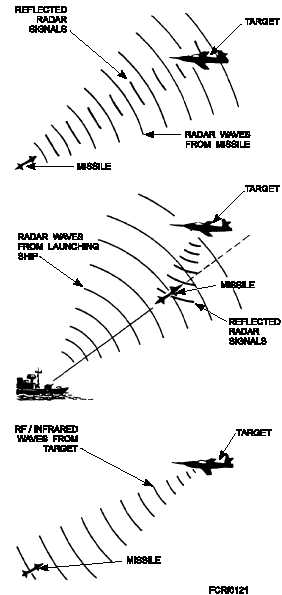Passive Homing.—Passive homing requires that
the target be a source of radiated energy (fig. 1-21, view
C). Typical forms of energy used in passive homing are
heat, light, and RF energy. One of the most common
uses of passive homing is with air-to-air missiles that
use heat-sensing devices. It is also used with missiles
that home on RF energy that originates at the target
(ships, aircraft, shore-based radar, and so forth). An
e x a m p l e o f t h i s i s t h e S TA N DA R D A R M
(anti-radiation missile) used for both air-to-surface and
surface-to-surface engagements. An advantage of this
type of homing is that the target cannot detect an attack
because the target is not illuminated.
Several missiles that normally use other homing
methods (active or semi-active) are capable of
switching to the passive home-on-jamming (HOJ)
mode in a countermeasure environment. That is, if
the target detects that it is being illuminated by an
active or semiactive guidance radar and initiates
jamming (RF interference), the missile will home on
the jamming signal if it is unable to maintain track on
the reflected illumination signal.
Tracking Radar/Fire-Control Radar
Radar that provides continuous positional data is
called tracking radar. Most tracking radar systems
used by the military are also called fire-control radars,
the two names being interchangeable. A fire-control
tracking radar system produces a very narrow,
circular beam.
PHASES OF RADAR OPERATION
The three sequential phases of radar operation
(designation, acquisition, and track) are often
referred to as modes and are common to the
target-processing sequence of most fire-control
radars.
Designation Phase
During the designation phase, the fire-control
radar is directed to the general location of the target.
Acquisition Phase
The fire-control radar switches to the acquisition
phase once its beam is in the general vicinity of the
target. During this phase, the radar system searches in
the designated area in a predetermined search pattern
until it either locates the target or is redesignated.
Track Phase
The fire-control radar enters into the track phase
when it locates the target. The radar system locks on
to the target during this phase.
Typical fire-control radar characteristics include
high pulse-repetition frequency, a very narrow
pulsewidth, and a very narrow beamwidth. A typical
fire-control antenna is shown in figure 1-22.
Detect-to-Engage Sequence
The basic sequence can be divided into six
fundamental operations: detection, acquisition and
tracking, prediction, launcher/gun positioning,
1-18
A.
B.
C.
Figure 1-21.—Homing guidance: A. Active homing; B.
Semi-active homing; C. Passive homing.


